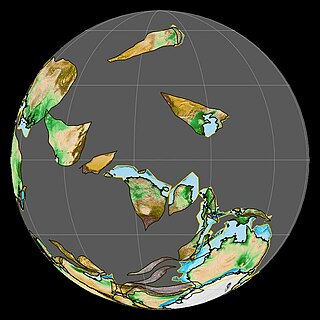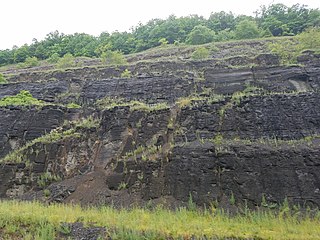Related Research Articles

Conodonts are an extinct group of eel-looking agnathan (jawless) vertebrates, classified in the class Conodonta. For many years, they were known only from fossils of their spiky oral elements, which are usually found in isolation and are now called conodont elements, while knowledge about soft tissues remains limited. A resilient group of prehistoric fish, conodonts existed in the world's oceans for over 300 million years, from the Cambrian to the beginning of the Jurassic. Due to their cosmopolitan distribution, conodont elements are widely used as index fossils, fossils used to define and identify geological periods.
The Bashkirian is in the International Commission on Stratigraphy geologic timescale the lowest stage or oldest age of the Pennsylvanian. The Bashkirian age lasted from 323.2 to 315.2 Ma, is preceded by the Serpukhovian and is followed by the Moscovian.

The Serpukhovian is in the ICS geologic timescale the uppermost stage or youngest age of the Mississippian, the lower subsystem of the Carboniferous. The Serpukhovian age lasted from 330.9 Ma to 323.2 Ma. It is preceded by the Visean and is followed by the Bashkirian. The Serpukhovian correlates with the lower part of the Namurian Stage of European stratigraphy and the middle and upper parts of the Chesterian Stage of North American stratigraphy.

Haptodus is an extinct genus of basal sphenacodonts, a member of the clade that includes therapsids and hence, mammals. It was at least 1.5 metres (5 ft) in length. It lived in present-day France during the Early Permian. It was a medium-sized predator, feeding on insects and small vertebrates.
The Kasimovian is a geochronologic age or chronostratigraphic stage in the ICS geologic timescale. It is the third stage in the Pennsylvanian, lasting from 307 to 303.7 Ma. The Kasimovian Stage follows the Moscovian and is followed by the Gzhelian. The Kasimovian saw an extinction event which occurred around 305 mya, referred to as the Carboniferous Rainforest Collapse. It roughly corresponds to the Missourian in North American geochronology and the Stephanian in western European geochronology.
Paleontology or palaeontology is the study of prehistoric life forms on Earth through the examination of plant and animal fossils. This includes the study of body fossils, tracks (ichnites), burrows, cast-off parts, fossilised feces (coprolites), palynomorphs and chemical residues. Because humans have encountered fossils for millennia, paleontology has a long history both before and after becoming formalized as a science. This article records significant discoveries and events related to paleontology that occurred or were published in the year 1933.

The Bluestone Formation is a geologic formation in West Virginia. It is the youngest unit of the Upper Mississippian-age Mauch Chunk Group. A pronounced unconformity separates the upper boundary of the Bluestone Formation from sandstones of the overlying Pennsylvanian-age Pocahontas Formation.
Cladodus is an extinct genus of cartilaginous fishes in the family Ctenacanthidae. As the name implies, they are a type of cladodont, primitive sharks with teeth designed to snag fish and swallow them whole, instead of sawing off chunks to swallow.
Idiognathodontidae is an extinct conodont family.
Spathognathodus is an extinct conodont genus in the family Spathognathodontidae. It is a non-Platform conodont, from the Pennsylvanian (Carboniferous).
Idiognathodus is an extinct conodont genus in the family Idiognathodontidae.
Gondolella is an extinct genus of conodonts in the family Gondolellidae.
Heinz Walter Kozur was a German paleontologist and stratigrapher.

Variabiloconus is an extinct genus of conodonts.
Conodonts are an extinct class of animals whose feeding apparatuses called teeth or elements are common microfossils found in strata dating from the Stage 10 of the Furongian, the fourth and final series of the Cambrian, to the Rhaetian stage of the Late Triassic. These elements can be used alternatively to or in correlation with other types of fossils in the subfield of the stratigraphy named biostratigraphy.
Siphonodella is an extinct genus of conodonts.
Neognathodus is an extinct genus of conodonts.
Declinognathodus is an extinct genus of platform conodonts.

Cavusgnathus is an extinct genus of conodonts.
Polygnathodella is an extinct genus of conodont.
References
- ↑ New Pennsylvanian conodonts from Oklahoma. RW Harris and RV Hollingsworth, American Journal of Science, March 1933, series 5, volume 25, no. 147, pages 193-204, doi:10.2475/ajs.s5-25.147.193
- ↑ Polygnathodella Harlton, 1933, or Idiognathoides Harris and Hollingsworth, 1933? Glen K. Merrill, Journal of Paleontology, March 1963, volume 37, issue 2 (abstract)
- Considerations of the Idiognathoides - Declinognathodus - Neognathodus complex of Middle Carboniferous platform conodonts. David L. Dunn, Lethaia, January 1971, volume 4, issue 1, pages 15–19, doi : 10.1111/j.1502-3931.1971.tb01276.x